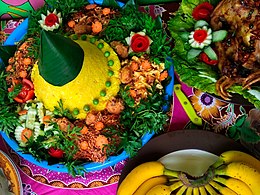


 |
| This article is part of the series on |
| Indonesian cuisine Masakan Indonesia |
|---|
|
National dishes |
|
Regional and cultural cuisines |
|
Ingredients |
|
Types of food
|
|
Preparation and cooking
|
|
Styles |
|
Holidays and festivals |
|
Related cuisines |
|
See also |
|
|
|
|
Indo cuisine is a fusion cooking and cuisine tradition, mainly existing in Indonesia and the Netherlands, as well as Belgium, South Africa and Suriname. This cuisine characterized of fusion cuisine that consists of original Indonesian cuisine with Eurasian-influences—mainly Dutch, also Portuguese, Spanish, French and British—and vice versa. Nowaday, not only Indo people consume Indo cuisine, but also Indonesians and Dutch people.
The Dutch colonial families through their domestic servants and cooks were exposed to Indonesian cuisine, as the result they developed a taste for native tropical spices and dishes. A notable Dutch East Indies colonial dish is rijsttafel, the rice table that consists of 7 to 40 popular dishes from across the colony. More an extravagant banquet than a dish, the Dutch colonials introduced the rice table not only so they could enjoy a wide array of dishes at a single setting but also to impress visitors with the exotic abundance of their colony.[1]
Through colonialism the Dutch introduced European dishes such as bread, cheese, barbecued steak and pancake. As the producer of cash crops; coffee and tea were also popular in the colonial East Indies. Bread, butter and margarine, sandwiches filled with ham, cheese or fruit jam, poffertjes, pannekoek and Dutch cheeses were commonly consumed by colonial Dutch and Indos during the colonial era. Some of the native upperclass ningrat (nobles) and a few educated native were exposed to European cuisine, and it was held with high esteem as the cuisine of upperclass elite of Dutch East Indies society. This led to the adoption and fusion of European cuisine into Indonesian cuisine. Some dishes which were created during the colonial era are Dutch influenced: they include selat solo (Solo salad), bistik jawa (Javanese beef steak), semur (from Dutch smoor), sayur kacang merah (brenebon) and sop buntut (oxtail soup). Cakes and cookies also can trace their origin to Dutch influences; such as kue bolu (tart), pandan cake, lapis legit (spekkoek), spiku (lapis Surabaya), klappertaart (coconut tart), and kaasstengels (cheese cookies). Kue cubit commonly found in front of schools and marketplaces are believed to be derived from poffertjes.[2]
Indo culinary culture has made an enduring impact on Dutch society. There is no other place outside Indonesia with such an abundance of Indonesian food available.[3] Indos played a pivotal role in introducing both Indonesian cuisine and Indo fusion cuisine to the Netherlands, making it so popular that some consider it an integral part of Dutch cuisine.[4] The Countess C. van Limburg Stirum writes in her book "The Art of Dutch Cooking" (1962): here exist countless Indonesian dishes, some of which take hours to prepare; but a few easy ones have become so popular that they can be regarded as "national dishes". She provides recipes for dishes that have become commonplace in the Netherlands: nasi goreng (fried rice), pisang goreng (fried bananas), lumpia goreng (fried spring rolls), bami (fried noodles), satay (grilled skewered meat), satay sauce (peanut sauce), and sambal ulek (chilli paste).[4] Most towns in the Netherlands will have an Indies or Indonesian restaurant and toko (shop). Even most Chinese restaurants have added Indonesian dishes to their menu such as babi panggang (roasted pork), and many now call themselves Chinese Indies Restaurants.[3]


|
| |
|---|---|
| Continental |
|
| National and regional |
|
| Ethnic |
|
| Religious |
|
| Historical |
|
| Styles |
|
| Lists |
|
| Related |
|
| |